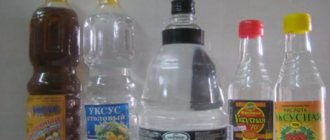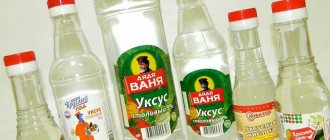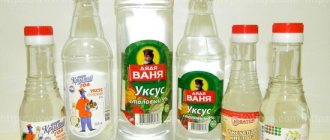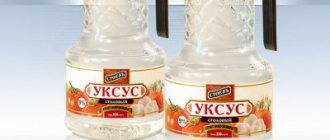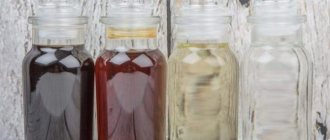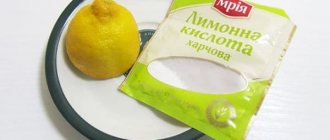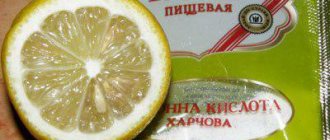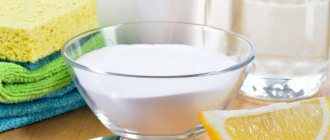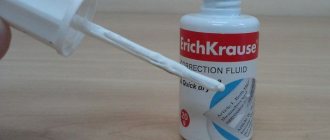Acetic acid is used in a large number of culinary recipes. It can also be used in the preparation of various medicinal mixtures according to folk schemes. Vinegar of varying concentrations can be used as an ingredient. Sometimes 70 percent is required, which is sold ready-made in the store. Sometimes a 3-, 5-, 7-, 9 percent solution is needed. To obtain it, you need to dilute the liquid that is already available. This way you can get a product suitable for any of your purposes. In this article you will learn how to dilute 70 percent vinegar.
Photo from the site: womenssecretszone.ru
How to make solutions of various concentrations at home
Concentrated vinegar 70% can be easily diluted with plain water. It’s easy and quick to make table vinegar of various strengths yourself at home, but you need to know the proportions of water and the ratio of acetic acid and essence to it.
There is a simple way to make 9 percent vinegar from 70 percent vinegar. To get 9% vinegar, add two tablespoons of 70% vinegar to a faceted glass of water. Agree, with a glass on hand it is easier to dilute and understand how to dilute the 70% essence.
It is important to use vinegar diluted in a glass of water for its intended purpose. By following the clear instructions of the recipe, you will be able to protect yourself from the dangerous effects of undiluted acetic acid on the human body. There is a formula for diluting vinegar, but with its help you need to do the calculations yourself. For convenience, we suggest using a hint on how much water and essence you need to take:
- By combining 1 part acid and 6 parts water, we get a 10% vinegar solution.
- How to dilute 70 vinegar to 9 percent? To obtain the required concentration, use a ratio of 1:7.
- To obtain 8 percent vinegar, mix 1 part vinegar with 8 parts water.
- For a 7% solution, a ratio of 1:9 is suitable.
- How to dilute vinegar 70 to 6? To get a 6% vinegar concentration, mix water and acid in a ratio of 11:1.
- Acetic essence and water in a ratio of 1:13 produces a 5% vinegar solution.
- Vinegar with a concentration of 4% is made from 17 parts water and 1 part acid.
- A 3% vinegar solution consists of 22.5 parts water and 1 part 70% vinegar essence.
Calculation of proportions
0
Source:
To correctly answer the question of how to dilute 70 vinegar to 9%, you should know that the presented product is divided into two types. In other words, it can be synthetic and natural. The latter seasoning is obtained as a result of long fermentation of various liquids that contain alcohols. Thus, there are apple, wine, and berry vinegars, as well as those infused with herbs and leaves of fruit bushes. As for synthetic vinegar, the main ingredient in it is acid. As a rule, it is obtained through chemical processes. They are often based on natural gas, wood distillation products, as well as some by-products obtained in industry.
0
Source:
Of course, ideally you should only eat natural vinegar. But synthetic ones can be safely used for household needs (for example, removing various stains, disinfecting, etc.). So, if you need to get highly concentrated table vinegar, then the essence should be diluted as follows: to get 30% table vinegar - 1.5 parts of ordinary drinking water; to obtain 10% table vinegar - 6 parts of ordinary drinking water; to obtain 9% table vinegar - 7 parts of ordinary drinking water; to obtain 8% table vinegar - 8 parts of ordinary drinking water; to obtain 7% table vinegar - 9 parts of ordinary drinking water. We suggest you read: How much and how to cook chicken eggs correctly
0
Source:
If you need to make low-concentrated table vinegar, then the 70% essence must be diluted in the following proportions: to obtain 6% table vinegar - 11 parts of ordinary drinking water; to obtain 5% table vinegar - 13 parts of ordinary drinking water; to obtain 4% table vinegar - 17 parts of ordinary drinking water; to obtain 3% table vinegar - 22.5 parts of ordinary drinking water.
How to dilute 9 percent vinegar to 6 percent and 3%
Diluted 9% vinegar often needs to be diluted to 6% or 3%; in other words, the existing 9% solution needs to be diluted. When diluting 9 percent vinegar, you can measure the liquid in milliliters or make calculations in grams.
- If you dilute two glasses of 9% vinegar with a glass of water, you get 6% table vinegar.
Following this formula, it is easy to answer the question of how to dilute 9 percent vinegar to 3 percent, or how to make 6 percent vinegar from 9 percent.
To dilute 70% acetic acid into solutions of other percentages, water will be required in certain proportions. You can find out how to dilute 70 percent vinegar from a convenient table.
Acetic essence 70% converted to 9% vinegar: table
Before looking for information on converting 70% acetic acid into 9% vinegar, pay attention to the vinegar dilution table with ready-made calculations on how to make 9% vinegar from 70% vinegar. The table for the concentration of vinegar 70% and the ratio of one part of it to parts of water will help you independently obtain a correctly diluted solution:
- Example: 3% vinegar is made from 1 part vinegar and 22 parts water;
- 4% – 1:17;
- 5% – 1:13;
- 6% – 1:11;
- 7% – 1:9;
- 8% – 1:8;
- 9% – 1:7;
- 10% – 1:6;
- 30% – 1:1,5;
- 40% – combine with 0.8 part of water.
How to dilute acetic acid 70% to 9% vinegar: table in spoons
An easy table for diluting acetic acid in spoons will give an equally accurate result. The table shows the proportions for diluting 1 tablespoon of 70 percent vinegar to the number of tablespoons of water
- An example of obtaining a 3% solution: 1 tbsp. vinegar and 22.5 tablespoons of water;
- 4%: 17 tablespoons;
- 5%: 13 tablespoons of water;
- 6%: 11;
- 7%: 9;
- 8%: 8;
- 9%: 7;
- 10%: 6;
- 20%: 2.5 tablespoons of water;
- 30%: 1.5 spoons.
Dilution table
A table for diluting types of vinegar and water is presented for visual use by housewives. It is designed not just for informational purposes. If you prepare a brine with undiluted essence, the vegetables may turn into a mush that is unsuitable for consumption. Find out if you can use balsamic vinegar.
| Conversion table for acetic acid concentrations per 1 liter of solution | ||||||||
| Concentration of the resulting solution | Initial concentration of acetic acid | |||||||
| 60% | 70% | 80% | 90% | |||||
| Acid, ml | Water, ml | Acid, ml | Water, ml | Acid, ml | Water, ml | Acid, ml | Water, ml | |
| 2% | 33 | 967 | 29 | 971 | 25 | 975 | 22 | 978 |
| 2,5% | 42 | 958 | 36 | 964 | 31 | 969 | 28 | 972 |
| 3% | 50 | 950 | 43 | 957 | 38 | 963 | 33 | 967 |
| 3,5% | 58 | 942 | 50 | 950 | 44 | 956 | 39 | 961 |
| 4% | 67 | 933 | 57 | 943 | 50 | 950 | 44 | 956 |
| 4,5% | 75 | 925 | 64 | 936 | 56 | 944 | 50 | 950 |
| 5% | 83 | 917 | 71 | 929 | 63 | 938 | 56 | 944 |
| 5,5% | 92 | 908 | 79 | 921 | 69 | 931 | 61 | 939 |
| 6% | 100 | 900 | 86 | 914 | 75 | 925 | 67 | 933 |
| 6,5% | 108 | 892 | 93 | 907 | 81 | 919 | 72 | 928 |
| 7% | 117 | 883 | 100 | 900 | 88 | 913 | 78 | 922 |
| 7,5% | 125 | 875 | 107 | 893 | 94 | 906 | 83 | 917 |
| 8% | 133 | 867 | 114 | 886 | 100 | 900 | 89 | 911 |
| 8,5% | 142 | 858 | 121 | 879 | 106 | 894 | 94 | 906 |
| 9% | 150 | 850 | 129 | 871 | 113 | 888 | 100 | 900 |
| 9,5% | 158 | 842 | 136 | 864 | 119 | 881 | 106 | 894 |
| 10% | 167 | 833 | 143 | 857 | 125 | 875 | 111 | 889 |
In what cases is it necessary to dilute vinegar?
At home, acetic acid is often used in cooking and as a traditional medicine. In diluted form, it is used externally to treat joints, heel spurs, and reduce elevated body temperature with vinegar compresses. For cosmetic purposes, a low concentration solution is used to rinse hair. The vinegar solution is used to wipe the skin of the face and body; apple cider vinegar is added to salads.
Diluted vinegar is included in mixtures against pests of cabbage, currants and indoor plants. The vinegar solution has an effective effect on tomatoes; gardeners use it to prevent late blight, against aphids on cucumbers, and to treat bell pepper ovaries against pests.
If you dilute vinegar correctly, its solution is suitable for any purpose. Vinegar inherently has a wide range of applications; it is used for various purposes. The sour-tasting solution serves as an indispensable seasoning for dumplings.
Diluted and undiluted 70% vinegar is added as a preservative for preparing homemade squash caviar for the winter, when marinating champignons in jars, wild mushrooms for future use and vegetables. As the main ingredient, vinegar can be found in almost all recipes for marinades of cabbage, meat kebabs with onions, and preparing sushi rice.
Variety of species
Vinegar is obtained by naturally souring fruit juices or dry grape wines. There are many varieties of the presented essence. Almost every country has a type of its own production that best suits the cuisine of that region.
The following types of vinegar are especially popular:
- red wine
– to create it, red wine cabernet, malbec or merlot is processed; - white wine
– characterized by a piquant taste, it is obtained by processing white wines; - balsamic
is the oldest variety in terms of production technology, which has existed for the second millennium. It is distinguished by the presence of a dark color, since the infusion process takes place in wooden barrels. The taste is soft, but quite rich, and the consistency is inherently viscous; - apple
- for its preparation, cider or apple pomace is taken as the starting product. This variety has an island-sour taste and an attractive amber color; - sherry
- its cost is higher than the previous ones, because The raw material for production is wine made from a special grape variety – Palomino Wine. In addition, it takes much longer to manufacture.
Interestingly, several thousand years earlier in Babylon, vinegar was made from dates. Then it was used in medicine as an antiseptic and hygiene product.
Less common, but still used in cooking, are the following types of vinegar: coconut, rice wine and malt.
Using diluted solutions of 3%, 5%, 6%, 7%, 9%, 10% and 25%
Concentrated vinegar essence can be easily and quickly diluted to regular table vinegar with plain water. Solutions of acetic acid of various concentrations are used for domestic purposes, their scope of application:
- A 3% concentration of solution is prepared for wiping against elevated body temperature in children. Used in cosmetic procedures, in cooking for dressing vegetable salads.
- 5% as a seasoning for manti, classic dumplings. In addition to main courses, it is used in salad dressings made from fresh vegetables: cabbage, cucumbers, and in vinaigrette dressing.
- 6% is added to the dough to make the pancakes fluffy and soft baked goods. They prepare marinades for chicken, marinate pork, and soften the hard fibers of beef. For medicinal purposes, for compresses to quickly reduce the temperature of an adult.
- 7% pickle onions, turnips, instant honey mushrooms for the winter, cloves and heads of garlic.
- A 9% aqueous solution of acetic acid in the form of food additive E 260 is poured into canned food before sealing cans with winter preparations: canned salads, winter adjika, homemade pepper lecho, tomato paste, tomato sauces. Winter dressing in a jar for borscht, soup seasoning, pickling of cucumbers for long-term storage is usually done with 9 percent vinegar to preserve canned food in winter.
- 10% – quick descaling in the kettle, elimination of unpleasant odors in the refrigerator. Disinfection and cleaning of plumbing fixtures and kitchen appliances.
- 25 and 30 percent acetic acid removes rust and breaks down fat. Used by gardeners and gardeners against weeds.
Product Types
The simplest answer to the question: “Where does vinegar come from?” - "From the shop". But let's expand our horizons a little today. Each of us can remember a case when an open bottle of wine or beer, left unfinished, turned sour after a while. During the process of souring or fermentation, acetic acid is formed.
Only natural food vinegar is obtained through fermentation. To do this, fermented alcohol-containing liquids are distilled and a concentrated vinegar essence is obtained, which subsequently ends up on store shelves.
We will tell you how to dilute vinegar essence to 9% vinegar later, but now a little about the types of this product. Today, several types of food vinegar are used for culinary purposes:
- Alcohol is a natural product without any aftertaste. It is obtained from an aqueous solution of ethyl alcohol.
- Rice is a product based on fermented rice or rice wine. It is indispensable as a flavorful seasoning.
- Balsamic is a natural product with a sweetish odor, dark color and thick consistency.
- Fruit is an excellent seasoning for vegetable salads and dumplings. Apple cider vinegar has gained popularity as a healing remedy.
- Flavored - a product obtained from alcohol vinegar by adding spicy and aromatic herbs.
- Malt - produced on the basis of barley malt. Accentuates the taste of prepared dishes and gives them tartness.
- Sherry - made from wine must from Muscatel or Palomino grape varieties.
- Synthetic - it is extracted from sawdust or in the production of mineral fertilizers from natural gas. It has a pronounced chemical taste and smell. It features low-cost production. It hits store shelves with the inscription “Dining”. The main difference from natural vinegar is the increased content of toxic and carcinogenic substances, but it impresses with its low cost.
How to replace vinegar essence with 70% vinegar
70% vinegar is usually used for canning. Vinegar essence 70% can be replaced with low concentration vinegar
- 1 part 70% acetic essence = 2.3 parts 30% acetic acid solution;
- 1 part 70% acetic essence = 2.8 parts 25% acetic acid solution;
- 1 part 70% vinegar essence = 7 parts 10% acetic acid solution;
- 1 part 70% vinegar essence = 8 parts 9% table vinegar;
- 1 part 70% vinegar essence = 12 parts 6% table vinegar;
- 1 part of 70% vinegar essence is equivalent to 14 parts of 5% table vinegar;
- 1 part of 70% vinegar essence can be replaced with 23 parts of 3% table vinegar.
Replacement is made taking into account the amount of water in the recipe. For example, if the ingredients of a canning recipe include water, its volume should be reduced by the amount of diluted vinegar added.
Knowing how to easily and quickly dilute 70% vinegar essence to obtain a percentage of 3%, 5%, 6% or 9% vinegar will save the family budget and, if you do not have a solution of the required concentration at home, will help you independently calculate how much water you need to dilute acetic acid.
How to dilute 9 vinegar from 70 essences is a frequently asked question from our readers. We hope that we have made the task easier for housewives, and now you know how to dilute vinegar, how to dilute acetic acid to table vinegar, and diluting a water-based solution at home will be easy and quick.
Precautionary measures
In conclusion, I would like to remind you about precautions when working with vinegar. Be careful when diluting the liquid; if the concentrate gets on your skin, the damaged areas must be quickly rinsed with plenty of cool water. Remember! The liquid itself and the vinegar vapor are toxic; inhaling them can easily cause a burn to the upper respiratory tract.
In acceptable concentrations, acetic acid is considered safe for human health; it can be eaten as a seasoning and used as a preservative for homemade pickles. Store diluted vinegar in a glass bottle out of the reach of children.
